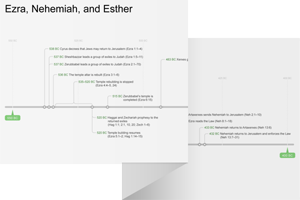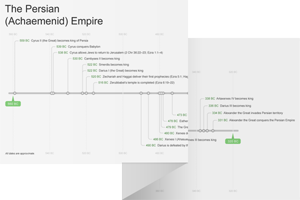8:1–20 Like the list of returnees who accompanied Zerubbabel in Ezra 2, this passage specifies who was part of the group that returned from Babylon with Ezra. Since exiles are still returning decades after Cyrus gave permission for them to return, it is clear that some Jews initially decided to stay in Babylon. From God’s perspective, the return to the land seems to have been obligatory—both Isaiah and Jeremiah call on the nation to return following the exile (e.g., Isa 48:20; Jer 31:16–21). However, respected biblical characters such as Ezra, Nehemiah, Mordecai, and Esther remained in exile. Thus, remaining in exile was not always viewed negatively. As an expert in the Scriptures (Ezra 7:6, 10), Ezra would have recognized that Yahweh wanted the Jews to return to Israel. But both Ezra and Nehemiah may have been prevented from returning because they held official positions in the king’s court. Both seem to require the express permission of the Persian king to return. The majority of the Jews were likely unable to return for financial reasons. Those who remained in Babylon had probably exhausted their resources by assisting those who initially returned (see 1:4, 6). Over time, those who remained built up their resources in order to return with Ezra. |
8:1 the reign of King Artaxerxes 458 bc.
8:2 Phinehas The only son of Aaron’s third son, Eleazar (Exod 6:23–25). This was also the genealogical line of which Ezra was a member (Ezra 7:5).
of Aaron’s third son, Eleazar (Exod 6:23–25). This was also the genealogical line of which Ezra was a member (Ezra 7:5).
Ithamar Aaron’s fourth son (Exod 6:23). Eleazar and Ithamar were the only sons of Aaron who had children.
Hattush The great-great-grandson of Zerubbabel (1 Chr 3:17–22).
8:3–14 Ezra 8:3–14 identifies 12 families. A common number in Scripture, 12 may have been used by Ezra to correspond to the 12 tribes of Israel. Each of the families mentioned here appears in the list of 2:3–15, with the exceptions of Shecaniah and Shelomith. In 2:6, Joab is included as part of the Pahath-moab family, but here he is independent. None of the names from 2:16–20 appear here. |
8:13 those who came last The Hebrew phrase used here indicates that these men constitute the rest of that family that had remained in Babylon. No other members of the family of Adonikam remained in Babylon after the return of Ezra.
8:15 the river that goes to Ahava One irrigation canal of the many that ran from the Euphrates to the Tigris, which flowed at a slightly lower elevation. Ahava and Casiphia (mentioned in v. 17) are probably in the general vicinity of Babylon.
of the many that ran from the Euphrates to the Tigris, which flowed at a slightly lower elevation. Ahava and Casiphia (mentioned in v. 17) are probably in the general vicinity of Babylon.
no one there from the sons of Levi Sheshbazzar also had difficulty finding Levites who were willing to return to Jerusalem (2:40–42). It is possible that a relatively low number of Levites were originally taken into captivity. Many may have been among the poorest people of the land (2 Kgs 24:14).
8:16 wise This expression is best understood as “diplomats” in light of the nature of their role.
8:17 head Probably indicates that Iddo served as the head priest at the sanctuary located at Casiphia.
Casiphia Possibly the location of a Jewish sanctuary. Support for this suggestion is found in the repeated use of the Hebrew term hammaqom (“the place”) in the OT to designate locations (e.g., Ge 13:3; Nu 11:3; Jer 27:22). The Hebrew term here is occasionally used with the meaning of “sanctuary” (e.g., Deut 12:5; Jer 7:3, 6, 7).
8:18 a man of understanding Perhaps a reference to his abilities in the law.
8:21–30 This passage recounts the preparations Ezra made at Ahava, praying for a safe journey and assigning priests to guard the gold, silver, and other precious objects bound for the temple in Jerusalem. |
8:21 I proclaimed a fast there Fasting commonly accompanies a time of great anxiety.
8:22 from enemies In ancient times, the roads between Babylon and Judah were teeming with gangs of bandits.
8:23 sought our God The combination of fasting with prayer is common in Scripture (Neh 1:4; Dan 9:3; Luke 2:37; 5:33; Acts 13:3; 14:23).
8:24 twelve of the official priests Ezra selects 12 priests. In the Pentateuch, the priests and Levites were given the responsibility of caring for the furnishings of the tabernacle (Num 3–4). In this passage, these groups are essentially given the same responsibility—with coins and vessels replacing furniture.
official priests: Sherebiah, Hashabiah However, Sherebiah and Hashabiah were not priests (Ezra 8:18–19).
8:26 six hundred and fifty talents of A Babylonian talent weighed approximately 75 pounds. 650 talents would equal 48,750 pounds, almost 25 tons.
weighed approximately 75 pounds. 650 talents would equal 48,750 pounds, almost 25 tons.
one hundred 7,500 pounds, almost four tons.
8:27 one thousand darics A thick gold coin that was named after the Persian king Darius. One side of the coin had a picture of the king with his crown while holding a bow and arrow (or javelin or dagger).
8:28 holy Set apart for a divine purpose.
8:31–36 After announcing their departure from Ahava in v. 31, the narrative immediately reports their arrival at Jerusalem in v. 32. According to 7:8–9, the journey took about four months. After a few days rest, the group turned over the silver and gold to the temple and offered sacrifices to Yahweh, probably in thanks for a safe journey. |
8:31 we set out The Hebrew term used here, nasa’, refers to the idea of pulling up tent pegs.
the twelfth day of the first month April 20, 458 bc, two days before Passover.
 Israelite Calendar Table
Israelite Calendar Table
 Israelite Festivals Table
Israelite Festivals Table
8:32 We came to Jerusalem The company arrived on August 4, 458 bc (7:9).
three days Possibly a time of rest following their rigorous journey. They may have also arrived late in the week and waited until the Sabbath was over before weighing out the valuables—an activity that would have been considered work. If the Jubilee calendar was being used, the exiles would have arrived on a Friday. In this case they would have naturally waited until at least Sunday.
8:33 fourth day August 7, 458 bc.
Meremoth Meremoth was of the line of Hakkoz, which had been unable to prove its ancestry (see 2:61–63; Neh 3:4, 21). Evidently, the family had been accepted when evaluated by the priest with Urim and Thummim.
8:34 The amount and weight of all The treasure would have been placed in one of the chambers of the temple (Ezra 8:29).
8:36 the king’s satraps and to the governor of Ezra presents his authorization to the local Persian officials (see 7:21–24). A satrap was typically a chief governor who ruled a satrapy that might be made up of smaller provinces and administrative districts, each overseen by a governor who reported to the satrap. Darius I divided the empire into 20 satrapies according to the Greek historian Herodotus (Histories 3.89). Syria-Palestine was part of the fifth satrapy, following Darius’ divisions (Histories 3.89).
the people of Probably refers to the new group of returnees being added to the Jewish presence in the land. Those who had returned previously were in need of additional numbers since they were surrounded by enemies (4:1).

|
About Faithlife Study BibleFaithlife Study Bible (FSB) is your guide to the ancient world of the Old and New Testaments, with study notes and articles that draw from a wide range of academic research. FSB helps you learn how to think about interpretation methods and issues so that you can gain a deeper understanding of the text. |
| Copyright |
Copyright 2012 Logos Bible Software. |
| Support Info | fsb |
 Loading…
Loading…


